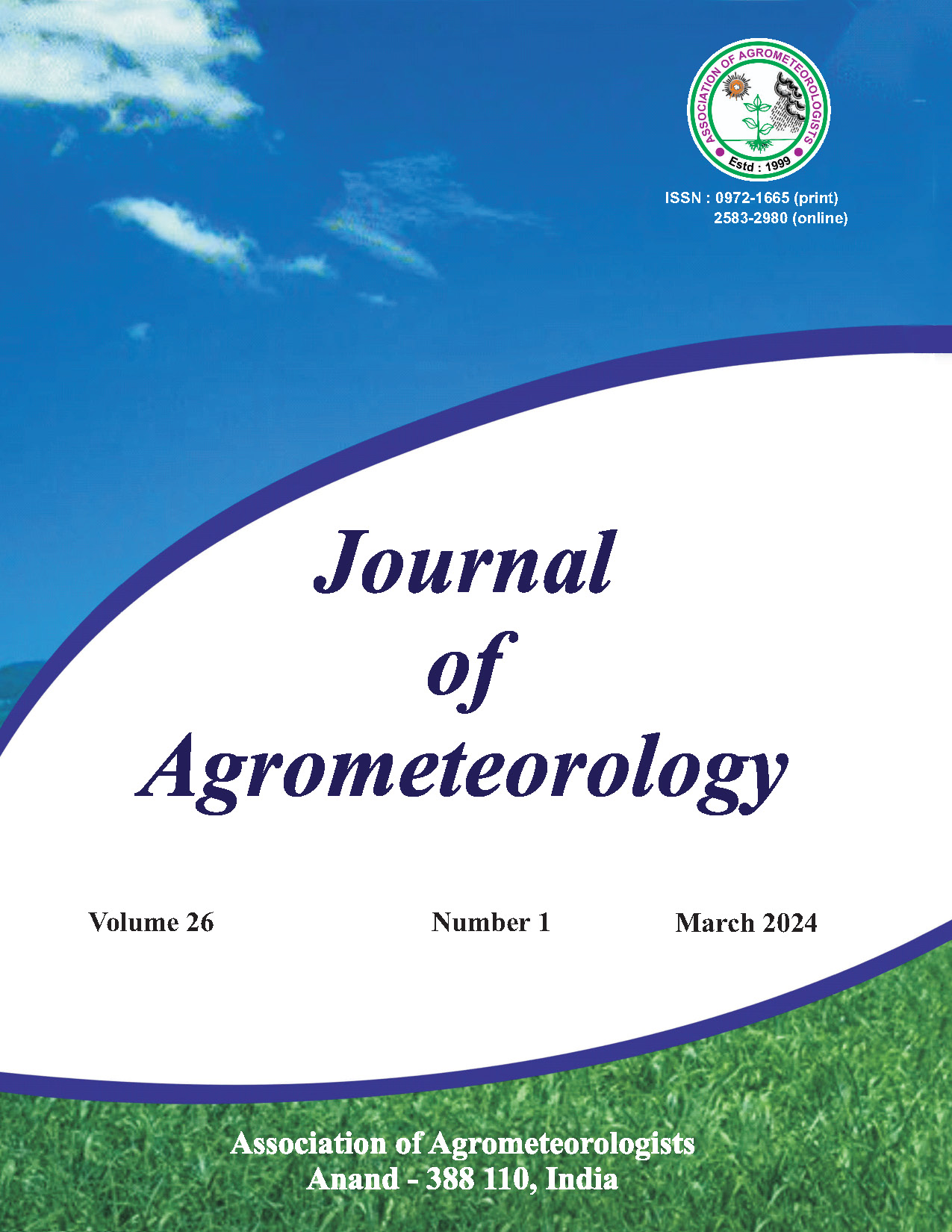Evaluation of soft-computing techniques for pan evaporation estimation
DOI:
https://doi.org/10.54386/jam.v26i1.2247Keywords:
Evaporation, Prediction, Neural network, Irrigation scheduling, LSTM networkAbstract
Estimation of pan evaporation (Epan) can be useful in judicious irrigation scheduling for enhancing agricultural water productivity. The aim of present study was to assess the efficacy of state-of-the-art LSTM and ANN for daily Epan estimation using meteorological data. Besides this, the effect of static time-series (Julian date) as additional input variable was investigated on performance of soft-computing techniques. For this purpose,the models were trained, tested and validated with eight meteorological variables of 37 years by using preceding 1-, 3- and 5- days’ information. Data were partitioned into three groups as training (60%), testing (20%), and validation (20%) components. It was observed that the models performed well (best) with preceding 5-days meteorological information followed by 3-days and 1-day. However, all LSTMs simulated peak value of Epan was more accurate as compared to lower values. Meteorological data with julian date improved the performance of LSTMs (0.75<NSE 1; PBias< 10; KGE 0.75). The ANN trained using only meteorological data (preceding 5-days information) had better performance error statistics among all other ANNs and LSTMs with minimum MAE (0.68 to 0.86), RMSE (0.93 to 1.22), PBias (-0.73 to 2.44) and maximum NSE (0.83 to 0.84) and KGE (0.89 to 0.92). Overall, it was inferred that the forecasting of meteorological parameters using a few days preceding information along with Julian date as the time series variables resulted in better estimation of Epan for the study region.
References
Abed, M., Imteaz, M. A., Ahmed, A. N. and Huang, Y.F. (2022). Modelling monthly pan evaporation utilising Random Forest and deep learning algorithms. Sci. Rep., 12(1): 13132.
Bicalho, K.V., Araujo, L.C., Cui, Y.J. and Dantas, B.T. (2016). Evaluation of empirical methods for estimating potential evaporation values in northeast France. In E3S Web of Conferences, EDP Sciences, 9:16005.
Chowdhury, S., Nanda, M.K., Saha, G. and Deka, N. (2010). Evaluation of different methods for evapotranspiration estimation using automatic weather station data. J. Agrometeorol., 12(1): 85-88. https://doi.org/10.54386/jam.v12i1.1277
Commeh, M.K., Agyei-Agyemang, A., Tawiah, P.O. andAsaaga, B.A. (2022). CFD analysis of a flat bottom institutional cookstove. Sci. Afr., 16: e01117.
Kim, S., Shiri, J., Singh, V.P., Kisi, O. and Landeras, G. (2015). Predicting daily pan evaporation by soft computing models with limited climatic data. Hydrol. Sci. J., 60(6): 1120-1136.
Kingra, P. K., Kaur, P., & Hundal, S. S. (2002). Estimation of PET by various methods and its relationship with mesh covered pan evaporation at Ludhiana. J. Agrometeorol., 4(2): 143–148. https://doi.org/10.54386/jam.v4i2.455
Kumar, A., Deo, M.M., Jeet, P., Kumari, A. and Prakash, O. (2022). Daily rainfall prediction for Bihar using artificial neural networks: Prediction of rainfall using ANN. J. AgriSearch., 9(4): 320-325.
Kumar, A., Sarangi, A., Singh, D.K., Khanna, M. and Singh, M. (2023). Prediction of relative humidity using soft computing techniques. J. Soil Water Conserv., 22(3): 280-286.
Majhi, B., Naidu, D., Mishra, A.P. andSatapathy, S.C. (2020). Improved prediction of daily pan evaporation using Deep-LSTM model. Neural. Comput. Appl., 32:7823-7838. doi.org/10.1007/s00521-019-04127-7
Naresh, R., Kumar, M., Kumar, S., Singh, K. and Sharma, P. (2023). Estimation of reference evapotranspiration using artificial neural network models for semi-arid region of Haryana. J. Agrometeorol., 25(1): 145-150. https://doi.org/10.54386/jam.v25i1.1914
Sharma, V., Singh, P. K., Bhakar, S. R., Yadav, K. K., Lakhawat, S. S. and Singh, M. (2021). Pan evaporation and sensor based approaches of irrigation scheduling for crop water requirement, growth and yield of okra. J. Agrometeorol., 23(4): 389-395. https://doi.org/10.54386/jam.v23i4.142.
Terzi, O. (2013). Daily pan evaporation estimation using gene expression programming and adaptive neural-based fuzzy inference system. Neural Comput. Appl., 23: 1035-1044. doi.org/10.1007/s0052 1-012-1027-x
Thiemig, V., Rojas, R., Zambrano-Bigiarini, M. and De-Roo, A. (2013). Hydrological evaluation of satellite-based rainfall estimates over the Volta and Baro-Akobo Basin. J. Hydrol., 499: 324-338.
Downloads
Published
How to Cite
License
Copyright (c) 2024 AMIT KUMAR, A. SARANGI, D.K. SINGH, I. MANI, K. K. BANDHYOPADHYAY, S. DASH, M. KHANNA

This work is licensed under a Creative Commons Attribution-NonCommercial-ShareAlike 4.0 International License.
This is a human-readable summary of (and not a substitute for) the license. Disclaimer.
You are free to:
Share — copy and redistribute the material in any medium or format
Adapt — remix, transform, and build upon the material
The licensor cannot revoke these freedoms as long as you follow the license terms.
Under the following terms:
Attribution — You must give appropriate credit, provide a link to the license, and indicate if changes were made. You may do so in any reasonable manner, but not in any way that suggests the licensor endorses you or your use.
NonCommercial — You may not use the material for commercial purposes.
ShareAlike — If you remix, transform, or build upon the material, you must distribute your contributions under the same license as the original.
No additional restrictions — You may not apply legal terms or technological measures that legally restrict others from doing anything the license permits.
Notices:
You do not have to comply with the license for elements of the material in the public domain or where your use is permitted by an applicable exception or limitation.
No warranties are given. The license may not give you all of the permissions necessary for your intended use. For example, other rights such as publicity, privacy, or moral rights may limit how you use the material.





